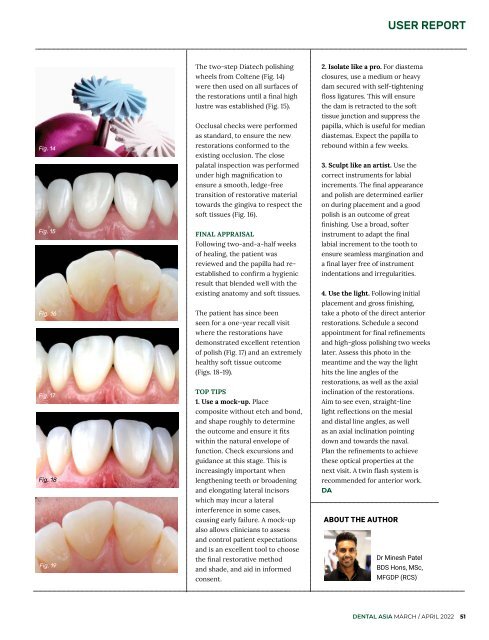Dental Asia March/April 2022
For more than two decades, Dental Asia is the premium journal in linking dental innovators and manufacturers to its rightful audience. We devote ourselves in showcasing the latest dental technology and share evidence-based clinical philosophies to serve as an educational platform to dental professionals. Our combined portfolio of print and digital media also allows us to reach a wider market and secure our position as the leading dental media in the Asia Pacific region while facilitating global interactions among our readers.
For more than two decades, Dental Asia is the premium journal in linking dental innovators and manufacturers to its rightful audience. We devote ourselves in showcasing the latest dental technology and share evidence-based clinical philosophies to serve as an educational platform to dental professionals. Our combined portfolio of print and digital media also allows us to reach a wider market and secure our position as the leading dental media in the Asia Pacific region while facilitating global interactions among our readers.
- No tags were found...
You also want an ePaper? Increase the reach of your titles
YUMPU automatically turns print PDFs into web optimized ePapers that Google loves.
USER REPORT<br />
Fig. 14<br />
Fig. 15<br />
Fig. 16<br />
Fig. 17<br />
Fig. 18<br />
ABOUT THE AUTHOR<br />
Fig. 19<br />
The two-step Diatech polishing<br />
wheels from Coltene (Fig. 14)<br />
were then used on all surfaces of<br />
the restorations until a final high<br />
lustre was established (Fig. 15).<br />
Occlusal checks were performed<br />
as standard, to ensure the new<br />
restorations conformed to the<br />
existing occlusion. The close<br />
palatal inspection was performed<br />
under high magnification to<br />
ensure a smooth, ledge-free<br />
transition of restorative material<br />
towards the gingiva to respect the<br />
soft tissues (Fig. 16).<br />
FINAL APPRAISAL<br />
Following two-and-a-half weeks<br />
of healing, the patient was<br />
reviewed and the papilla had reestablished<br />
to confirm a hygienic<br />
result that blended well with the<br />
existing anatomy and soft tissues.<br />
The patient has since been<br />
seen for a one-year recall visit<br />
where the restorations have<br />
demonstrated excellent retention<br />
of polish (Fig. 17) and an extremely<br />
healthy soft tissue outcome<br />
(Figs. 18-19).<br />
TOP TIPS<br />
1. Use a mock-up. Place<br />
composite without etch and bond,<br />
and shape roughly to determine<br />
the outcome and ensure it fits<br />
within the natural envelope of<br />
function. Check excursions and<br />
guidance at this stage. This is<br />
increasingly important when<br />
lengthening teeth or broadening<br />
and elongating lateral incisors<br />
which may incur a lateral<br />
interference in some cases,<br />
causing early failure. A mock-up<br />
also allows clinicians to assess<br />
and control patient expectations<br />
and is an excellent tool to choose<br />
the final restorative method<br />
and shade, and aid in informed<br />
consent.<br />
2. Isolate like a pro. For diastema<br />
closures, use a medium or heavy<br />
dam secured with self-tightening<br />
floss ligatures. This will ensure<br />
the dam is retracted to the soft<br />
tissue junction and suppress the<br />
papilla, which is useful for median<br />
diastemas. Expect the papilla to<br />
rebound within a few weeks.<br />
3. Sculpt like an artist. Use the<br />
correct instruments for labial<br />
increments. The final appearance<br />
and polish are determined earlier<br />
on during placement and a good<br />
polish is an outcome of great<br />
finishing. Use a broad, softer<br />
instrument to adapt the final<br />
labial increment to the tooth to<br />
ensure seamless margination and<br />
a final layer free of instrument<br />
indentations and irregularities.<br />
4. Use the light. Following initial<br />
placement and gross finishing,<br />
take a photo of the direct anterior<br />
restorations. Schedule a second<br />
appointment for final refinements<br />
and high-gloss polishing two weeks<br />
later. Assess this photo in the<br />
meantime and the way the light<br />
hits the line angles of the<br />
restorations, as well as the axial<br />
inclination of the restorations.<br />
Aim to see even, straight-line<br />
light reflections on the mesial<br />
and distal line angles, as well<br />
as an axial inclination pointing<br />
down and towards the naval.<br />
Plan the refinements to achieve<br />
these optical properties at the<br />
next visit. A twin flash system is<br />
recommended for anterior work.<br />
DA<br />
ABOUT THE AUTHOR<br />
DENTAL ASIA MARCH / APRIL <strong>2022</strong> 51


















